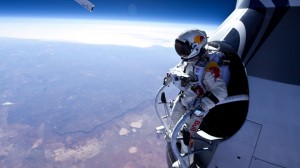 Folks, skydiving history will soon be made.
Folks, skydiving history will soon be made.
Felix Baumgartner, Austrian aviation specialist, plans to leap out of a space capsule from an altitude of 120,000 feet, rocketing his way at predicted speeds of over 700 mph to the earth’s surface.
UPDATE:
[highlight color=”yellow”]10/14 | 3:42pm EST: And he did it. WAHOO![/highlight]
Quick Essentials
Some quick facts you should know:
> The planned jump is 120,000 feet, or 22 miles above the Arizona desert
> The freefall should be around 5 minutes and 30 seconds. Felix Baumgartner is predicted to break Mach 1, the speed of sound, ripping through the air at speeds of over 700 miles per hour.
> Baumgartner will travel in a 55-story high balloon, built out of a polyethylene plastic that happens to be one-tenth the thickness of a sandwich bag. This balloon is incredibly lightweight and will carry him all the way from the ground up to 120,000 feet.
Check out this CGI video to get a visual sense of what to expect:
[youtube id=”VCqnQq86fkY” width=”600″ height=”350″]
The History: Seven Years, Felix Baumgartner and Red Bull
Called the Red Bull Stratos Project, this multi-million dollar, seven-yar endeavor involves experts in the field of aeronautics, engineering and medicine.
Felix Baumgartner, the protagonist in this epic storyboard, is a 43-year old former Austrian paratrooper who has 2500+ jumps to his name. Baumgartner’s celebrated history of daredevil stunts include world records for the lowest BASE jump and for being the first to skydive across the English Channel. Who comes up with ideas like this?
[youtube id=”r-TCO2IdoTA” width=”600″ height=”350″]
In the video above, you’ll get a stronger sense of the complexities of the project. Joe Kittinger, meteorologist and current world record holder, has been advising Felix throughout the process. In 1960, Kittinger jumped from 102,800 feet, as part of Project Excelsior.
During initial bouts of claustrophobia, Kittinger helped Felix develop a 40-item checklist to help ease his mind. Even though a specially designed balloon carries Baumgartner upward at a speed of 1000 feet/minute, there is significant alone time in the process.
If the jump proves successful, Baumgartner plans to hand his 25+ year daredevil drawers up, to settle down with his girlfriend and to fly a rescue helicopter. The man recognizes that he has been pushing the limits — this is his final hoorah.
Check out this video of Felix Baumgartner performing a 96,000 foot, second test jump over the summer.
[youtube id=”s_SzUnkYcR4″ width=”600″ height=”350″]
The Jump: 22 Miles, 700+ MPH
Click the image below for a play-by-play mission timeline:
What Could Go Wrong
Unfortunately, a lot could go wrong.
For one, Baumgartner could find himself in a flat spin. In low air, high-altitude dives like this, an uncontrolled flat spin could push Baumgartner to an unconscious state. He could face temporary blindness as blood rushes to his head and extremities. Yikes.
It is predicted that Baumgartner will step out of his capsule into temperatures of minus 10 degrees Fahrenheit. As he rockets toward earth, he could experience up to minus 70 degrees Fahrenheit. Fortunately, his custom-designed space suit should protect him up to temperatures of minus 90 degrees.
When Baumgartner’s body approaches the speed of sound, shock-shock interaction could endanger his pressurized suit. Hopefully, because these sonic forces are less intense when the air is thin, it won’t be an issue.
The Skydiving Suit: Custom-Engineered

Any skydive above 62,000 feet requires a pressurized suit. Otherwise, water in the body turns to gas, and the body distends via a process called ebullism.
Not fun.
Red Bull partnered up with the David Clark Company, based out of Massachusetts, to create a custom suit modeled on those worn by Air Force pilots during high-altitude recon missions.
The suit has four layers — a liner, a bladder fitted to Baumgartner’s body, mesh to hold the bladder in place and a flame-retardant exterior. The suit is designed to protect Baumgartner from a fairly large temperature range, -90 to 100 degrees Fahrenheit, with a ventilation hose to provide warm or cool air as needed.
The composite helmet weighs 8 pounds, with a retractable sunshade visor and an integrated heating circuit to prevent fogging. The helmet is also equipped with an oxygen regulator that will pump out 100% oxygen during the ascent and descent. A drinking port will provide Baumgartner with enough water.
Finally, five cameras will live on the suit to film what will undoubtedly be the ride of Baumgartner’s life.
Follow Along in Real Time
The whole shebang will be broadcast live, without feed delay or interference — an engineering marvel, I might add — from Red Bull Stratos.
There are also several tweets from Red Bull – below are a few notables:
https://twitter.com/RedBullStratos/status/255415156702584832
https://twitter.com/RedBullStratos/status/255466402809516032
https://twitter.com/RedBullStratos/status/255313839053221888
https://twitter.com/RedBullStratos/status/255158801370603520
https://twitter.com/RedBullStratos/status/254740216185778176
[photos via Red Bull Content Pool]
- An Anatomically Correct Nut Tool for Climbers - 5 June, 2015
- Obstacle Race Training Guide - 4 June, 2015
- Using Night Vision in Extreme Sports - 25 March, 2015


